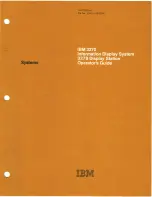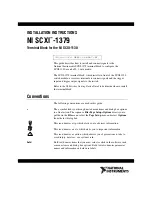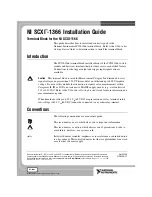
Mounting and wiring
EL6731
23
Version: 2.8
Cable-based transmission
This version, which accords with the American EIA RS-485 standard, was specified as a basic version for
applications in production engineering, building management and drive technology. A twisted copper cable
with one pair of conductors is used. Depending on the intended application area (EMC aspects should be
considered) the screening may be omitted.
Two types of conductor are available, with differing maximum conductor lengths (see the RS-485 table).
RS485 - Fundamental properties
RS-485 transmission according to the PROFIBUS standard
Network topology
Linear bus, active bus terminator at both ends, stubs are possible.
Medium
Screened twisted cable, screening may be omitted, depending upon
the environmental conditions (EMC).
Number of stations
32 stations in each segment with no repeater. Can be extended to 127
stations with repeater
Max. bus length without repeater
100 m at 12 Mbit/s
200 m at 1500 Kbit/s, up to 1.2 km at 93.75 kbit/s
Max. bus length with repeater
Line amplifiers, or repeaters, can increase the bus length up to 10 km.
The number of repeaters possible is at least 3, and, depending on the
manufacturer, may be up to 10.
Transmission speed (adjustable in
steps)
9.6 kbit/s; 19.2 kbit/s; 93.75 kbit/s; 187.5 kbit/s; 500 kbit/s; 1500 kbit/s;
12 Mbit/s
Connector
9-pin D-Sub connector for IP20
M12 round connector for IP65/67
Cabling for PROFIBUS DP and PROFIBUS FMS
Note the special requirements on the data cable for baud rates greater than 1.5 Mbaud. The correct cable is
a basic requirement for correct operation of the bus system. If a simple 1.5 Mbaud cable is used, reflections
and excessive attenuation can lead to some surprising phenomena. It is possible, for instance, for a
connected PROFIBUS station not to achieve a connection, but for it to be included again when the
neighboring station is disconnected. Or there may be transmission errors when a specific bit pattern is
transmitted. The result of this can be that when the equipment is not operating, PROFIBUS works without
faults, but that there are apparently random bus errors after start-up. Reducing the baud rate (< 93.75 kbaud)
corrects this faulty behavior.
If reducing the baud rate does not correct the error, then in many cases this can indicate a wiring fault. The
two data lines may be crossed over at one or more connectors, or the termination resistors may not be
active, or they may be active at the wrong locations.
Recommended cables
Installation is made a great deal more straightforward if preassembled cables from Beckhoff are
used! Wiring errors are avoided, and commissioning is more rapidly completed. The Beckhoff range
includes fieldbus cables, power supply cables, sensor cables and accessories such as termination
resistors and T-pieces. Connectors and cables for field assembly are nevertheless also available.
Fig. 16: PROFIBUS cable assignment
















































